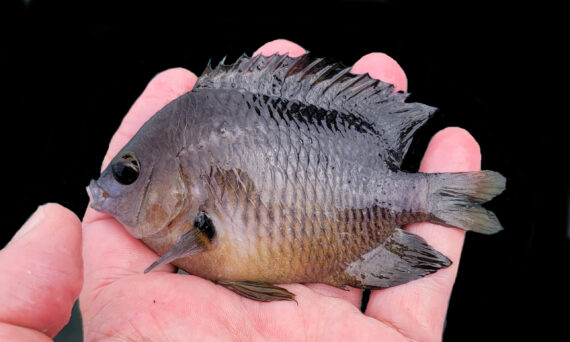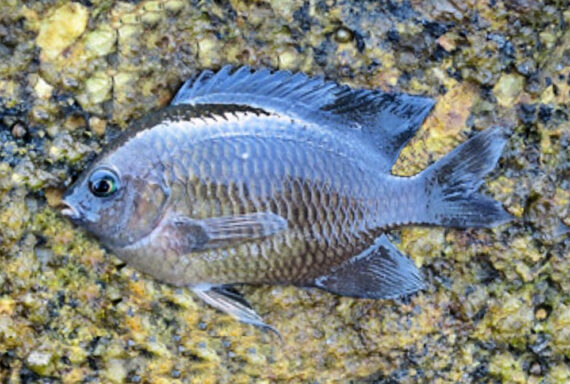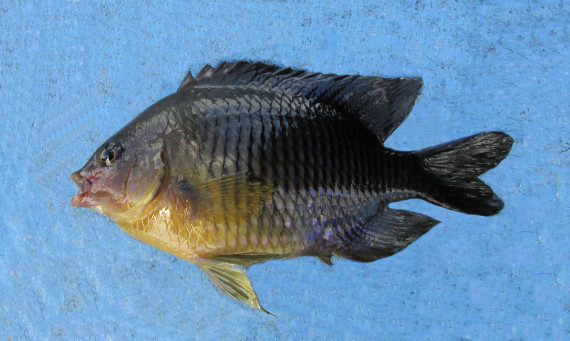Threespot Damselfish, Stegastes planifrons
 Threespot Damselfish, Stegastes planifrons. Fish caught from coastal waters off Miami, Florida, November 2023. Length: 9.5 cm (3.7 inches). Catch, photograph and identification courtesy of Chris Moore, Peoria, Arizona.
Threespot Damselfish, Stegastes planifrons. Fish caught from coastal waters off Miami, Florida, November 2023. Length: 9.5 cm (3.7 inches). Catch, photograph and identification courtesy of Chris Moore, Peoria, Arizona.
 Threespot Damselfish, Stegastes planifrons. Fish caught from coastal waters off Penang, Malaysia, December 2013. Length: 10 cm (3.9 inches). Catch, photograph and identification courtesy of Eli (obsessiveangling.wordpress.com).
Threespot Damselfish, Stegastes planifrons. Fish caught from coastal waters off Penang, Malaysia, December 2013. Length: 10 cm (3.9 inches). Catch, photograph and identification courtesy of Eli (obsessiveangling.wordpress.com).
 Threespot Damselfish, Stegastes planifrons. Fish caught off the Channel 5 Bridge (MM 71.4), Florida Keys, Florida, December 2015. Length: 12 cm (4.7 inches). Catch, photograph and identification courtesy of George Brinkman, Guelph, Ontario, Canada.
Threespot Damselfish, Stegastes planifrons. Fish caught off the Channel 5 Bridge (MM 71.4), Florida Keys, Florida, December 2015. Length: 12 cm (4.7 inches). Catch, photograph and identification courtesy of George Brinkman, Guelph, Ontario, Canada.
The Threespot Damselfish, Stegastes planifrons, is a member of the Damselfish or Pomacentridae Family, that is also known as the Three-spotted Jacket and the Yellow Chopita and in Mexico as jaqueta de tres puntos. Globally, there are forty species in the genus Stegastes, of which eleven are found in Mexican waters, seven in the Atlantic and four in the Pacific Ocean.
The Threespot Damselfish has a deep oval compressed body that is 45% to 49% of standard length, thus similar in nature to freshwater bluegills. Adults are gray-brown with their lower head and lower body being tan in color. They have 3 distinct black spots with thin blue rims (after which they are named): the first at the base of their dorsal fin between the spines and the rays; the second on top of their caudal fin peduncle; and the third at the base of their pectoral fin. Their head and upper body have a few tiny blue spots and the top of their eyes is yellow. Juveniles have a bright yellow body, bright yellow fins, and a large black spot at the base of their dorsal fin under the last spines. They also have a smaller black spot on their upper caudal fin base. Their head has a small protrusible mouth that opens in the front with a single row of long and close-set incisor teeth. They have serrated gill covers. Their anal fin has 2 spines and 13 or 14 rays; their caudal fin is bluntly forked; and, their dorsal fin is singular and continuous with 12 spines and 15 to 17 rays. Their anal and dorsal fins are long, extend past the tail base, and have large rounded lobes. They have 8 or 9 gill rakers on their lower arch. Their body is covered with large rough scales. Their lateral line is incomplete and ends under the edge of their dorsal fin base.
The Threespot Damselfish is a demersal species that is found in shallow reefs environments at depths up to 30 m (100 feet). They prefer reefs with large numbers of Staghorn Hydrocorals, Acropora cervicornis, and take shelter in caves at night. They reach a maximum of 12.5 cm (4.9 inches) in length. They are diurnal feeders consuming primarily algae, benthic invertebrates and plankton. They are very aggressive with their feeding habits and when defending their territory. Reproduction is oviparous with pairing of individuals. Eggs are distributed demersal adhering to the substrate due to their stickiness and are guarded by the males. The Threespot Damselfish is poorly studied with very limited information available about their lifestyle and behavioral patterns including specific details on age, growth, longevity, movement patterns, diet, habitat use, and reproduction.
The Threespot Damselfish is a resident of all Mexican waters of the Atlantic Ocean including the Gulf of Mexico and the Caribbean.
The Threespot Damselfish can easily be confused with the Cocoa Damselfish, Stegastes variabilis (yellow anal, caudal, and pectoral fins) and the Longfin Damselfish, Stegastes diencaeus (anal fin with blue margin).
From a conservation perspective the Threespot Damselfish is currently considered to be of Least Concern with stable, widely distributed populations. They are small in stature and of limited interest to most. They are classic nibblers, thus difficult to catch by hook and line. They are sold on a very limited basis by the aquarium trade.